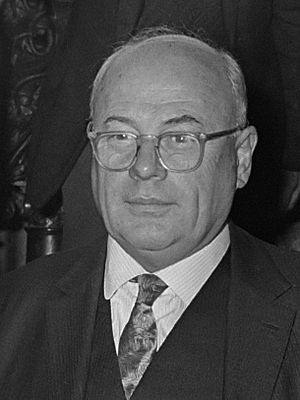Kurt Mendelssohn facts for kids
Quick facts for kids
Kurt Mendelssohn
|
|
|---|---|
 |
|
| Born | 7 January 1906 |
| Died | 18 September 1980 (aged 74) Oxford, UK
|
| Citizenship | British |
| Alma mater | University of Berlin |
| Awards | Hughes Medal (1967), Fellow of the Royal Society |
| Scientific career | |
| Fields | Physicist |
| Institutions | University of Oxford |
| Doctoral advisor | Franz Eugen Simon |
| Other academic advisors | Max Planck Walther Nernst Erwin Schrödinger Albert Einstein |
| Doctoral students | Harold Max Rosenberg |
| Influenced | David Stanley Evans |
| Signature | |
Kurt Alfred Georg Mendelssohn (born January 7, 1906, in Berlin, Germany – died September 18, 1980) was a very smart scientist. He was born in Germany but later became a British citizen. He was a physicist who studied how things work at very cold temperatures. In 1951, he became a Fellow of the Royal Society, which is a big honor for scientists in the UK.
Contents
Family and Early Life
Kurt Mendelssohn was the only child of Ernst Moritz Mendelssohn and Elizabeth Ruprecht. His family was part of the famous Mendelssohn family. This family included the philosopher Moses Mendelssohn. Kurt also had cousins who were scientists, like Francis Simon.
In 1932, Kurt married Jutte Zarniko. Her sister, Barbara, was a student of his cousin, Franz Simon.
A Scientist's Journey
Kurt Mendelssohn earned his top science degree, a doctorate, from the Humboldt University of Berlin. He learned from some of the most famous scientists of his time. These included Max Planck, Walther Nernst, Erwin Schrödinger, and even Albert Einstein.
In 1930, a scientist named Frederick Lindemann visited Berlin. He wanted to buy a special machine. This machine could make liquid hydrogen, which is super cold. Mendelssohn helped show how the machine worked. Lindemann was so impressed that he asked Kurt to come work in Oxford University in England.
At first, Kurt couldn't go. He had just accepted a job in Breslau, where his cousin Franz Simon was a professor. But Lindemann didn't give up! In 1932, he invited Kurt to Oxford again. This time, Kurt helped set up a machine that could make liquid helium.
By 1933, Kurt Mendelssohn moved to England. He started working at the University of Oxford. He became a Reader in Physics there from 1955 to 1973. This meant he was a senior researcher and teacher.
What Kurt Mendelssohn Studied
Kurt Mendelssohn's main work was in low temperature physics. This is the study of how materials behave when they are extremely cold. He also studied other things like transuranic elements. These are elements heavier than uranium. Later in his career, he worked in medical physics. This field uses physics to help with medicine and health.
Awards and Recognition
Kurt Mendelssohn received important awards for his scientific work. In 1967, he was given the Hughes Medal by the Royal Society. The next year, in 1968, he won the Simon Memorial Prize. These awards showed how important his contributions to science were.
The Mystery of the Pyramids
In 1974, Kurt Mendelssohn wrote a book called The Riddle of the Pyramids. In this book, he tried to explain why and how the earliest Egyptian pyramids were built. Even though he wasn't an Egyptologist (someone who studies ancient Egypt), he used his knowledge of physics. He also got advice from experts and visited Egypt and Mexico himself.
Mendelssohn's Pyramid Ideas
His main idea was that the pyramid at Meidum collapsed while it was being built. He thought of this in 1966. He saw pictures of a disaster where a lot of rubble fell. He noticed it looked similar to the rubble around the Meidum pyramid.
From this idea, he developed a theory about pyramid building. He thought that building pyramids in Egypt became a huge project. It happened during the Third and Fourth Dynasties. He believed it was almost like a continuous project, not just one pyramid for each pharaoh.
Mendelssohn's theory tried to answer some big questions about pyramids:
- During the time when the biggest Egyptian pyramids were built, there were only three pharaohs. But there were five pyramids built (including Meidum). Mendelssohn suggested why this might be.
- He thought that pyramids were built as cenotaphs. These are monuments to honor someone, but they don't necessarily contain a tomb. This meant they didn't have to be finished exactly during a pharaoh's lifetime.
- Building the Great Pyramids needed a huge number of workers. Many of these workers had to be very skilled. As a pyramid got taller, fewer people could work on it at the same time. Mendelssohn believed that as soon as one pyramid was about halfway done, work would start on the next one. This way, the skilled workers could keep busy.
- The Bent Pyramid has a strange change in its angle. Mendelssohn thought this change happened because of the collapse of the Meidum Pyramid. He suggested that these pyramids were built with some overlap, not one after another.
Even though his theory isn't widely accepted by Egyptologists today, his book is still a very interesting study of the Egyptian pyramids.
Books by Kurt Mendelssohn
Kurt Mendelssohn wrote several books during his life:
- The Riddle of the Pyramids. Thames & Hudson, 1974.
- The Quest for Absolute Zero. McGraw-Hill, 1966.
- In China Now, 1969.
- The World of Walther Nernst, University of Pittsburgh Press, 1973.
- Science and Western Domination, Thames & Hudson, 1976.

